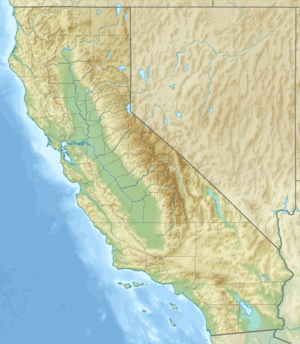Chileno Creek facts for kids
Quick facts for kids Chileno Creek |
|
|---|---|
|
Location of the mouth of Chileno Creek in California
|
|
| Country | United States |
| State | California |
| Region | Marin County |
| District | West Marin |
| Physical characteristics | |
| Main source | Laguna Lake 226 ft (69 m) 38°12′28″N 122°45′53″W / 38.20778°N 122.76472°W |
| River mouth | Confluence with Walker Creek 62 ft (19 m) 38°12′44″N 122°51′35″W / 38.21222°N 122.85972°W |
| Length | 6.25 mi (10.06 km) |
Chileno Creek is a small river, also called a stream, located in the western part of Marin County, California, in the United States. It starts near Petaluma, California at a place called Laguna Lake. This lake is quite big, about 220 acres, and sits between Marin and Sonoma Counties. From Laguna Lake, Chileno Creek flows west for about 6.25 kilometers (around 3.9 miles). It then joins Walker Creek, which eventually flows into Tomales Bay.
Contents
What's in the Name? The History of Chileno Creek
Chileno Creek gets its name from Chilean immigrants. These people settled in the Chileno Valley. They were encouraged to move there by a person named Adrian Godoy.
Who Owned Chileno Valley Ranch?
One important ranch in the area is Chileno Valley Ranch. In 1862, Carlo Martinoiya bought this ranch. He was an immigrant from Cevio, Switzerland. He bought it from Henry Halleck, who was a very important general during the American Civil War. General Halleck was even President Abraham Lincoln's Chief of Staff.
Carlo Martinoiya changed his name to Charles Martin. Today, his great-great-granddaughter, Sally Gale, and her husband run one of the ranches in the Chileno Valley.
Protecting the Land
Many ranches in the Chileno Valley watershed are kept as farmland. This is thanks to the Marin Agricultural Land Trust (MALT). MALT helps protect these lands so they can continue to be used for farming.
Where Does Chileno Creek Flow?
The area that Chileno Creek drains is called its watershed. This watershed covers about 20.25 square miles (52.5 square kilometers). The creek begins at Laguna Lake. This lake is a shallow, natural lake at the start of the Chileno Valley. Even though it's called a "vernal pool" (which usually dry up), Laguna Lake keeps some water all year long.
How High and Low is the Creek?
The land in the Chileno Creek watershed changes a lot in height. It goes from about 1,379 feet (420 meters) high down to 62 feet (19 meters) low. The lowest point is where Chileno Creek meets Walker Creek.
Dams and Sediment
A study looked at how Chileno Creek's land and water interact. It found that about 30% of the natural dirt and sand (called sediment) in the watershed is stopped by small dams. These dams were built for livestock ponds. When sediment is blocked, it can cause the creek banks downstream to wear away, which is called erosion. It also slows down the recovery of plants along the creek. Many of the smaller streams that flow into Chileno Creek also have dams.
Animals and Fish in Chileno Creek
In the early 1900s, a type of fish called coho salmon was very common in Walker Creek. However, their numbers dropped a lot. This was likely because of severe erosion and too much dirt in the water. This problem was caused by too many animals eating plants (overgrazing) and by logging (cutting down trees).
Fish Populations Today
In 1975, a scientist named D. W. Kelley studied the fish. He looked at steelhead trout and coho salmon. He found only a few young steelhead trout in the area. He found only eight coho salmon near where Chileno Creek and Walker Creek meet. Also, a dam called Soulajule Reservoir dam blocked all fish that swim upriver from the ocean (anadromous fish) from reaching Arroyo Sausal.
To help the fish, the California Department of Fish and Game (CDFG) started putting coho salmon from Olema Creek into Walker Creek in 2003. This has had some success. In 2008 and again in 2013, coho salmon returned to Walker Creek, Salmon Creek, and Frink Canyon.
Birds of Laguna Lake
Laguna Lake is a very important place for birds. Many whistling swans, a type of waterfowl, use the lake. They visit during the winter and also use it for breeding.


